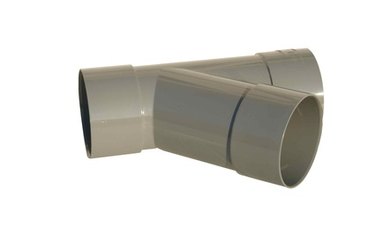Things You'll Need
Marker pen
Tape measure
Handsaw
Utility knife
PVC primer
PVC connecting coupling
PVC cement
Schedule 40 PVC pipe
PVC couplings

Schedule 40 PVC pipe is the standard strength/thickness pipe used in most household sewer lines. Schedule 80 and 120 are PVC pipes with the same outside diameter as Schedule 40 but with thicker walls (this makes the inner diameter smaller than schedule 40). All these types of PVC pipe sections are converted into sewer lines with primer, cement and PVC couplings and generally come in 8-foot lengths. The new PVC sewer pipe joins into the home's main sewer line (running from the sewer or septic tank) and runs and connects to the new water fixture.
Step 1
Mark the main sewer line at the place where the new schedule 40 PVC sewer pipe will connect to it. Make a second mark 2 inches along the sewer line from the first mark. Use a handsaw to cut through both marks: The cuts must be straight and parallel with each other. Remove all burrs from the cut pipe ends with a utility knife.
Video of the Day
Step 2
Apply PVC primer around the outside ends of both pipe cuts, as well as the inside ends of a PVC connecting coupling. Apply PVC cement to all primed areas. Squeeze the connecting coupling between the cut pipe ends, with the coupling's side spout facing up and in the direction of the new water fixture. Hold the coupling to the pipes for five seconds while the cement dries.
Step 3
Measure and cut to length the first section of schedule 40 PVC sewer pipe. Remove burrs. Prime one outside end of the pipe and the inside end of the connecting coupling's side spout. Apply PVC cement to both areas and push the pipe into the spout. Hold in place for five seconds.
Step 4
Cut to length the second section of schedule 40 PVC sewer pipe. Remove burrs. Prime one end, and also prime the remaining end of the first section of PVC pipe. Then prime the inside of a PVC coupling.
Step 5
Apply PVC cement to all primed areas. Push the coupling onto the end of the first section of pipe and push the second section of pipe into the other end of the coupling. Hold in place for five seconds. Measure, cut and install all remaining sections of PVC pipe until the new pipeline reaches the water fixture.
Tip
Sinks, showers and washing machines connect to the end of the new sewer pipe with P-traps.
Toilets connect to the sewer pipe with toilet flanges.
All horizontal sections of sewer pipe must be installed at a gradient so the waste will travel along the pipe and run out to the sewer/septic tank. Consult local building codes for the correct gradient in your area.
The sewer pipe can also be cut with a hacksaw, circular saw or miter saw.
PVC couplings are available in 30, 45, 60, 90 and 180-degree (straight) angles.
The connecting coupling will be the same diameter as the home's main sewer line. Its side spout will be the same diameter as the new schedule 40 PVC sewer line.
Warning
Wear eye protection when cutting PVC pipe.
Video of the Day